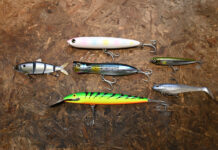Bottom fishing with bait is great, but one missed nibble and you’re fishing on credit. To target larger fish and weed out undesirables, anglers turn to vertically jigging a swimbait or metal spoon. Dropping a heavy lure to the bottom and working it to the surface is effective on deep water fish from walleye and lake trout to tuna and grouper.
Simple Tips On Vertical Jigging
Dropping, jerking, cranking and yanking from a kayak could be an Olympic sport. Northern California commercial kayak fisherman, Kevin Hofer spends his day zeroing in on structure and bouncing heavy jigs with big rods. “It’s quite relaxing,” he says.

Develop a Feel for the Bottom
Turning physical abuse into relaxing pastime takes proper technique and targeted application. “Learn to read the bottom,” Hofer suggests. With practice, he can detect soft sand from hard rock by feeling his jig hit the bottom.
Using his fish finder to detect hard bottom, drops and pinnacles and spotting the tops of kelp on the surface, ensures Hofer is in the right place. A good fish finder will use color codes to indicate harder bottom, which usually shows up as a thinner line than softer bottom.
Once on the scene, Hofer drifts through the area bouncing his jig along the bottom. Anglers working their spoon or swimbait through the water column may find it easier to crank the reel while jigging the rod by kneeling in the kayak. Raising the rod tip off the water allows for greater range of motion and more comfortable form.
Going Jigging? Surf’s Up!
One of the most important boat handling skills for ocean anglers is crossing the surf line. “Knowing how the kayak handles surf goes a long way in making it out and back,” Hofer says. Get to know the kayak by practicing surfing in an empty boat on gentle waves.

Learn to read the beach structure looking for deep sloughs providing easier passage. Going out is easier than coming in. To launch, stand ready, watch the biggest waves pass and time the lull between sets. At the best opportunity, pull the kayak past the shore break and enter when the seat is in waist-deep water. Keep the bow pointed towards the breakers and aim for the lowest part of the wave. When faced with a breaker, hold the paddle parallel to the kayak and lean forward into the white water.
Surf entry is the worst. Try to store rods, reels and tackle below deck. Secure all other gear with straps and bungees. It’s best not to leash the paddle to the kayak. Slowly work towards shore. As soon as a wave passes, start hauling freight for the beach. Keep up speed to stay between waves. If caught by a breaker, keep the kayak facing the beach and paddle like a bat out of hell. Before crossing the shore break, wait for a wave to pass and follow it up the sand.
As soon as the boat is in waist-deep water, jump out of the seat, run forward, grab the bow handle and pull the rig up the beach.
This article was first published in the Fall 2019 issue of Kayak Angler Magazine. Subscribe to Kayak Angler Magazine’s print and digital editions, or browse the archives.
Dropping, jerking, cranking and yanking? Vertical jigging could be an Olympic sport. | Feature photo: Kevin Hofer







Can Ken please share his top 5 lures and top 5 swim baits? That would have been much more helpful then the several paragraphs about launching and returning through the surf. That in itself should be a whole article.
thanks, Dan